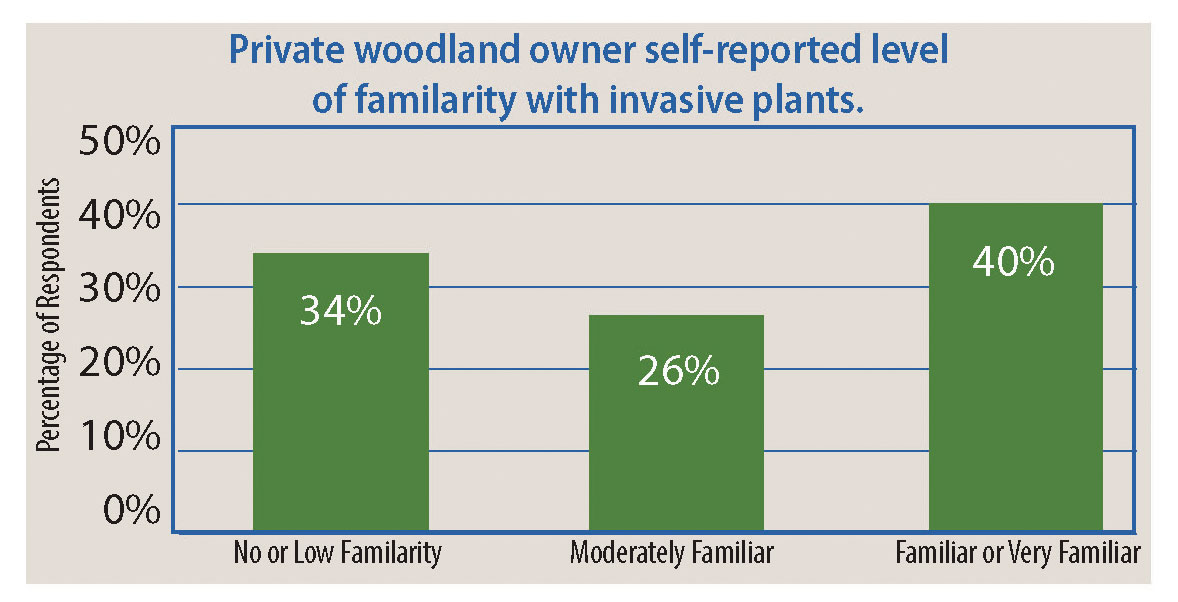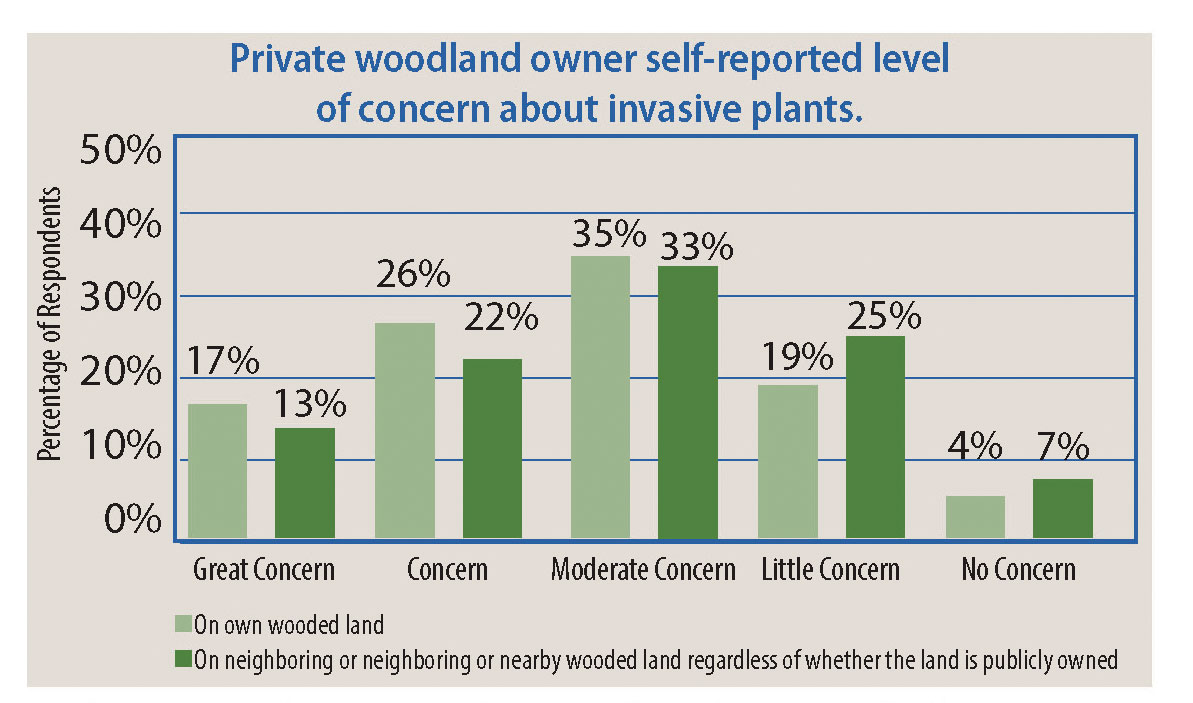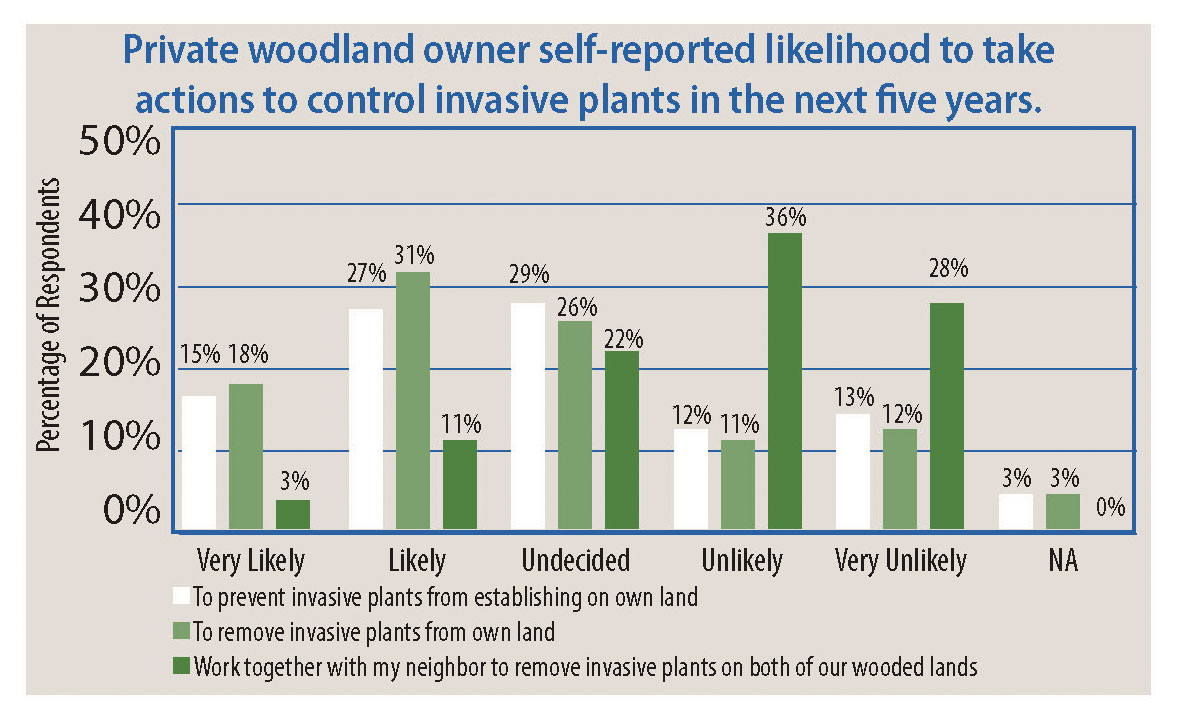What do our Private Woodland Owners Know and Are Doing about Invasive Plants in Indiana?
By Mysha Clarke and Zhao Ma
Invasive plants are nonnative (or alien) plant species to the ecosystem under consideration whose introduction does or is likely to cause economic or environmental hard or hard to human health1. Invasive plants can displace native plants, reduce wildlife habitat, and reduce forest health, productivity and resilience2-4. Invasive plants are one of the leading causes of biodiversity loss; approximately 42% of threatened or endangered species in the United States are at risk primarily due to invasive plant and animal species5,6. Invasive species are costing the American public an estimated $137 billion each year due to productivity loss and management costs such as herbicide application7. More locally, Indiana landowners and managers spent $5.85 million in 2012 alone to manage invasive plants according to a survey conducted by the Invasive Plant Advisory Committee of the Indiana Invasive Species Council8.
The majority of woody invasive plants in the United States were introduced for horticultural purposes, while many of the herbaceous invasive plants were introduced through crop seed contaminated with weed seed or through seeds in soil brought over from other countries9,10. Today, consumers can still find invasive plant species sold as ornamentals in nurseries around the country11,12. The most prominent characteristics of invasive plants include large amount of seeds for dispersal, aggressive competition of available resources, rapid reproduction, absence natural enemies or pests in the established ecosystems, and high tolerance of various environmental conditions particularly under climate change13-15.
It is very important to know what private woodland owners know and are doing to control invasive plants on their property. In the United States, 36% of woodlands are owned by 10.7 million private individuals and families16; and in Indiana, 87% of the timberland are owned by approximately 190,000 private landowners17. Each landowner may assume responsibility for only a small portion of the total damages caused by invasive plants; however, together their individual decisions to manage or not to manage will determine the success or failure of invasive plant control across the landscape. Some landowners opting not to control invasive plants will increase the control costs for neighboring private and public landowners by allowing their land to act as an invader propagule source18,19. Therefore, invasive plant control is not just an individual problem but a community- and landscape-level problem that transcends all property lines.
The Policy and Human Dimensions Lab in the Department of Forestry and Natural Resources at Purdue University recently completed a study focusing on invasive plant management on private woodlands. As part of this study, we interviewed 25 forestry professionals and private woodland owners, and surveyed 2,600 randomly selected private woodland owners in the state. The objective of this study was to assess (1) private woodland owners’ current knowledge and awareness of invasive plants and the associated management strategies; (2) management actions that they have taken to control invasive plants; (3) the types and sources of information used to assist them in making invasive plant management decisions; and, (4) the challenges and opportunities associated with managing invasive plants on private woodlands. Below is a brief summary of the survey results from this study.
Who are the private woodland owners in Indiana?
The size of land holding varies greatly among private woodland owners in Indiana. Based on our survey results, respondents owned between 1 and 2,000 acres of woodland with a mean of 81 acres. Thirty-seven percent of our respondents were the single owner of their woodland, 52% owned their woodland with their spouse or another individual, and the remaining 11% owned their woodland jointly with multiple people. On average, our survey respondents had been the owner of their woodland for 25 years, although there were also some brand new owners as well as long-term owners with more than 50 years of experience. Thirty percent of our survey respondents were considered absentee owners who lived more than 1 mile away from their woodland. About 20% of our survey respondents had a written forest management plan, and over a third had participated in the Indiana Classified Forest and Wildlands Program. Generally speaking, our survey respondents were older (an average of 63 years old), and many were retired (49%). Although the majority of our survey respondents were men, women were the primary owner and decision maker for a quarter of the private woodlands represented by our survey sample. Most private woodland owners nationwide derive little income from their woodland; in fact, our survey respondents reported that on average 1% of their household income was coming from their woodland. Also similar to the private woodland owners nationwide (Butler et al. 2016), our survey respondents owned their woodland mostly for amenity rather than resource extraction reasons. Their top five reasons for woodland ownership were: (1) to enjoy scenery or beauty, (2) to protect or improve wildlife habitat, (3) to protect nature and biological diversity, (4) to pass land onto children or other heirs, and (5) for privacy. Only a third of our survey respondents owned their woodland for the purpose of producing timber products, such as logs or pulpwood.
What do private woodland owners know about invasive plants in Indiana?
Our survey results suggest that 40% of private woodland owners in Indiana were familiar or very familiar with invasive plant problems. These landowners could identify some or all of the invasive plant species around where they lived. At the same time, a little over a third (34%) of our survey respondents reported no or low familiarity with invasive plants. These landowners had never heard of invasive plants before taking the survey, or had heard of them but did not know much about them. The remaining 26% of our survey respondents reported moderate familiarity, meaning that they knew about invasive plants but could not identify specific invasive plant species.
Our survey results also suggest that private woodland owners have noticed a large number of invasive plants species on their property in Indiana. The table below contains all the species reported by our survey respondents, as well as the percentage of survey respondents who reported those species. Notably, multiflora rose was the most noticed species on private woodlands in Indiana.
When asked about how they first noticed or became aware of invasive plants on their woodland in Indiana, 15% of our survey respondents reported that a forestry or natural resource professional from a federal or state program saw invasive plants on their property and told them about it, while 10% were told by their family and friends. In addition, 15% of our survey respondents saw information about invasive plants in a forestry newsletter or magazine and then found them on their property, while 11% learned about invasive plants from the media (e.g., newspapers, television, radio, etc.).
Regardless of landowner awareness of invasive plant problems in general or on their property, the majority of our survey respondents were concerned about invasive plants. Over three quarters (77%) reported a moderate to great level of concern about invasive plants on their own woodland, while 68% reported a moderate to great level of concern about invasive plants on neighboring or nearby privately or publicly owned woodland.
What are private woodland owners doing about invasive plants in Indiana?
Many private woodland owners in Indiana are already taking actions to manage invasive plants on their property. Generally speaking, their actions fall into four categories: physical removal, chemical treatment, obtaining information and seeking assistance, and discussing the problem with neighbors and other landowners. The table below shows the wide range of self-reported actions by our survey respondents. While many private woodland owners may be actively engaged in invasive plant management, it is important to note that 38% of our survey respondents reported having done nothing about invasive plants. This is concerning because unmanaged properties may become a seed source of invasive plants and undermine the long-term effectiveness of control actions taken by other landowners.
Despite the wide range of actions taken to control invasive plants, private woodland owners generally do not have a lot of confidence in their own ability to effectively prevent and remove invasive plants. Only 20% of our survey respondents reported that they were confident or very confident in their own ability to remove invasive plants from their woodland, and even a smaller percentage (12%) reported confidence regarding preventing invasive plants from establishing on their woodland. Moreover, in terms of overall effort, 79% of our survey respondents believed that Indiana as a whole was not doing enough about preventing and removing invasive plants from private woodlands.
What do private woodland owners plan to do about invasive plants in Indiana?
Looking into the next five years, 42% of our survey respondents reported that they were likely or very likely to take actions to prevent invasive plants from establishing on their woodland, and 49% were likely or very likely to take actions to remove invasive plants from their woodland. This also means that over half of private woodland owners did not plan to take any actions in the next five years.
Another result that is worth noting is that among those who had plan to take actions, most planned to work individually rather than working together with their neighbors and other woodland owners to tackle the problem.  At the same time, 67% of our survey respondents believed that effective control and removal of invasive plants requires woodland owners to work together, and 43% believed that Indiana needs some coordinated effort to control invasive plants on private woodlands. In fact, many felt a certain level of social pressure within the landowner community to control invasive plants. Specifically, 71% of our survey respondents said if their neighbors were controlling or removing invasive plants from their woodland, they would feel the need to do the same; or if other woodland owners (not necessarily their neighbors) were controlling and removing invasive plants, they would feel the need to do the same. Further, most of our survey respondents (69%) believed that a “good” woodland owner should control or remove invasive plants from their property to reduce potential spread onto other neighbors’ property.
At the same time, 67% of our survey respondents believed that effective control and removal of invasive plants requires woodland owners to work together, and 43% believed that Indiana needs some coordinated effort to control invasive plants on private woodlands. In fact, many felt a certain level of social pressure within the landowner community to control invasive plants. Specifically, 71% of our survey respondents said if their neighbors were controlling or removing invasive plants from their woodland, they would feel the need to do the same; or if other woodland owners (not necessarily their neighbors) were controlling and removing invasive plants, they would feel the need to do the same. Further, most of our survey respondents (69%) believed that a “good” woodland owner should control or remove invasive plants from their property to reduce potential spread onto other neighbors’ property.
These results suggest that many private woodland owners view the invasive plant problem as a land stewardship problem that all landowners share the responsibility to address. This further suggests a need for perhaps more opportunities for private woodland owners to communicate with each other, voluntarily coordinate their individual actions, collaborate in terms of sharing information and equipment, and support each other as they engage in this important yet challenging task of invasive plant control. Such collective efforts, however, are unlikely to occur without facilitation and assistance. Sixty-nine percent of our survey respondents told us that although the idea of landowners working together sounds great, it would be hard to implement. Many (62%) stated that this is partly because it is difficult for private woodland owners to self-organize and cooperate with one another on their own.
Acknowledgement
We thank Purdue University College of Agriculture AgSEED program and the USDA Forest Service Northern Research Station (FS Agreement No. 15-JV-11242309-037) for their support. We also thank all the private woodland owners in Indiana who participated in our survey and provided us with great insights.
Mysha Clarke (clarke15@purdue.edu) is a doctoral student specializing in natural resources social science in the Department of Forestry and Natural Resources at Purdue University. Zhao Ma (zhaoma@purdue.edu) is an associate professor of sustainable natural resources social sciences in the Department of Forestry and Natural Resources at Purdue University. References are available online at www.inwoodlands.org.
References cited
1 National Invasive Species Information Center. 2017. Accessed on March 27, 2017, from https://www.invasivespeciesinfo.gov/.
2 Fei, S., Phillips, J., Shouse, M. 2014. Biogeomorphic impacts of invasive species. Annual Review of Ecology, Evolution and Systematics 45: 69-87.
3 Rotherham, I.D., Lambert, R.A. 2013. Balancing species history, human culture and scientific insights: introduction and overview. In I.D. Rotherham and R.A. Lambert (eds.): Invasive and Introduced Plants and Animals: Human Perceptions, Attitudes and Approaches to Management, pp. 3-18. New York, NY: Routledge.
4 Simberloff, D., Martin, J., Genovesi, P., Maris, V., Wardle, D.A., Aronson, J., Courchamp, F., Galil, B., Garcia-Berthou, E., Pascal, M., Pysek, P., Sousa, R., Tacacchi, E., Vilà, M. 2013. Impacts of biological invasions: what’s what and the way forward. Trends in Ecology & Evolution 28(1): 58-66.
5 National Invasive Species Council. 2006. Invasive Species Definition Clarification and Guidance White Paper. Accessed on March 27, 2017, from https://www.invasivespeciesinfo.gov/.
6 National Wildlife Federation. 2017. Invasive Species. Accessed on March 27, 2017, from https://www.nwf.org/.
7 Pimentel, D., Zuniga, R. Morrison, D. 2005. Update on the environmental and economic costs associated with alien-invasive species in the United States. Ecological Economics 52(3): 273-288.
8 Indiana Invasive Species Council. 2013. Report from the Invasive Plant Advisory Committee to the Indiana Invasive Species Council. Assessed on March 27, 2017, from http://www.entm.purdue.edu/iisc/.
9 Reichard, S.H., White, P. 2001. Horticulture as a pathway of invasive plant introductions in the United States. BioScience 51(2): 103-113.
10 Conser, C., Seebacher, L., Fujino, D.W., Reichard, S., DiTomaso, J.M. 2015. The development of a plant risk evaluation (PRE) tool for assessing the invasive potential of ornamental plants. PLoS ONE 10(3): e0121053.
11 Gagliardi, J.A., Brand, M.H. 2007. Connecticut nursery and landscape industry preferences for solutions to the sale and use of invasive plants. HortTechnology 17(1): 39-45.
12 Drew, J., Anderson, N., Andow, D. 2010. Conundrums of a complex vector for invasive species control: a detailed examination of the horticultural industry. Biological Invasions 12(8): 2837-2851.
13 Swearingen, J., Slattery, B., Reshetiloff, K., Zwicker, S. 2010. Plant Invaders of Mid-Atlantic Natural Areas (4th ed). Washington, D.C.: National Park Service and U.S. Fish and Wildlife Service, 168pp.
14 Hellmann, J.J., Byers, J.E., Bierwagen, B.G., Dukes, J.S. 2008. Five potential consequences of climate change for invasive species. Conservation Biology 22(3): 534-543.
15 Ruiz, G.M., Carlton, J.T. 2003. Invasion vectors: a conceptual framework for management. In G.M. Ruiz and J.T. Carlton (eds.): Invasive Species: Vectors and Management Strategies, pp. 457-504. Washington, D.C.: Island Press.
16 Butler, B.J., Hewes, J.H., Dickinson, B.J., Andrejczyk, K., Butler, S.M., Markowski-Lindsay, M. 2016. Family forest ownerships of the United States, 2013: findings from the USDA Forest Service’s National Woodland Owner Survey. Journal of Forestry 114(6): 638-647.
17 Indiana Department of Natural Resources. Undated. Indiana Forest Facts. Assessed on March 27, 2017, from http://www.in.gov/dnr/forestry/2881.htm.
18 Epanchin-Niell, R.S., Hufford, M.B., Aslan, C.E., Sexton, J.P., Port, J.E., Waring, T.M. 2010. Controlling invasive species in complex social landscapes. Frontiers in Ecology and the Environment 8(4): 210-216.
19 Simberloff, D., Parker, I.M., Windle, P.N. 2005. Introduced species policy, management, and future research needs. Frontiers in Ecology and the Environment 3: 12-20.
Invasive Plant Species % of Survey Resondents
Multiflora rose.................................................................. 64%
Asian bush honeysuckle .................................................. 33%
Japanese honeysuckle...................................................... 29%
Autumn olive.................................................................... 28%
Other (written-in: Russian olive,
wild grape vine, canary grass, etc.)............................. 23%
Garlic mustard.................................................................. 20%
Ailanthus/tree of heaven................................................. 19%
Burning bush.................................................................... 13%
Common buckthorn........................................................... 8%
Japanese stilt grass............................................................. 6%
Periwinkle........................................................................... 6%
Winter creeper.................................................................... 5%
Japanese barberry.............................................................. 4%
Callery pear or Bradford pear............................................. 4%
Privet.................................................................................. 4%
Paulownia........................................................................... 2%
Glossy buckthorn................................................................ 2%
Invasive Plant Control Actions % of Survey Respondents
I pulled or cut invasive plants on my wooded land. ..................... 39%
I inspected my wooded land for invasive plants. ......................... 34%
I applied herbicides to kill invasive plants on my wooded land... 31%
I searched for information about invasive plants on the Internet. 15%
I talked to my family about invasive plants.................................. 14%
I contacted a forestry/NR professional about invasive plants....... 11%
I talked to other woodland owner (not my neighbor)
about invasive plants................................................................. 10%
I talked to my neighboring woodland owner about invasive plants. 8%
I sought technical assistance from a forestry/NR
professional about removal......................................................... 5%
I participated in workshops or information sessions
about invasive plants................................................................... 5%
I sought financial assistance from a state or federal
program to remove...................................................................... 4%
I used prescribed fire to kill invasive plants on my wooded land... 3%
I participated in a county/state/federal program assisting
landowners to remove................................................................. 2%
I worked with my neighbor to remove from both of our wooded lands. 2%
